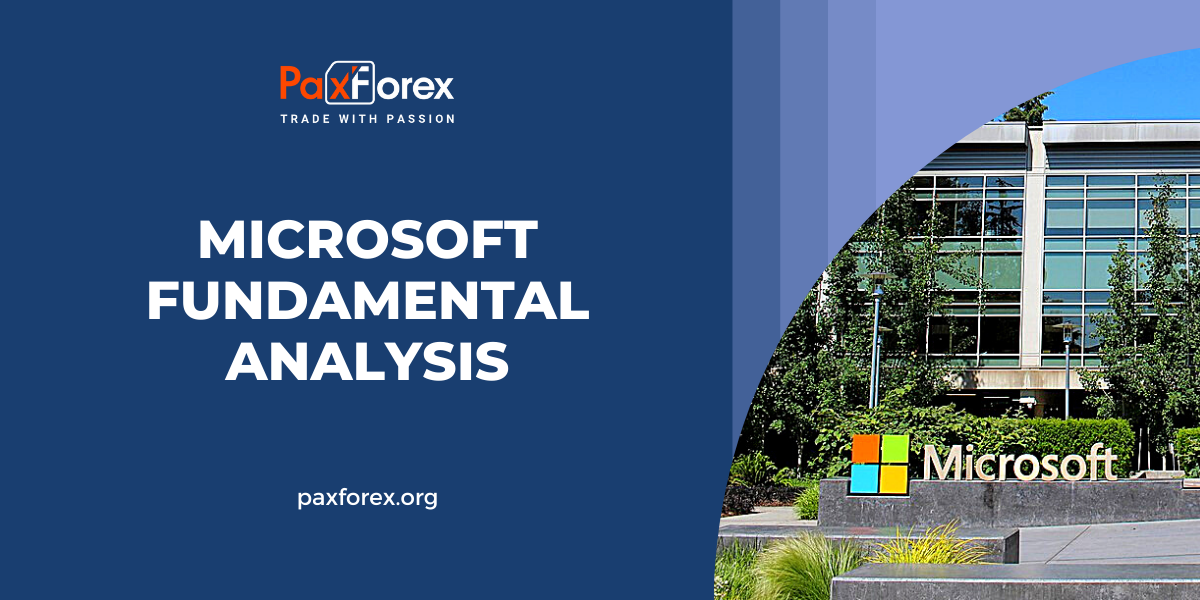
Source: PaxForex Premium Analytics Portal, Fundamental Insight
After an almost two-year-long journey, Microsoft has successfully concluded its acquisition of Activision Blizzard. Despite the regulatory hurdles and concessions Microsoft had to navigate, the deal has been finalized. Activision Blizzard is now officially integrated into Microsoft, contributing to the company's top and bottom lines.
While Microsoft has been a strong performer in the stock market in recent years, its valuation has become relatively high. With Microsoft putting a substantial portion of its cash reserves to work through the $68.7 billion acquisition of Activision, it raises the question: Is Microsoft now an attractive investment? Let's explore this further.
As of the fourth quarter of fiscal year 2023 (ending June 30), Microsoft held over $111 billion in cash and equivalents on its balance sheet. With the significant acquisition of Activision, it has allocated a considerable portion of its cash reserves to this strategic move, which appears to offer compelling value.
Before the merger, Activision boasted a robust profit margin of 25%. The post-merger scenario allows for the consolidation of various roles, leading to potential improvements in the profit margins within the newly integrated business segment. Furthermore, Microsoft can leverage its resources to enhance product development, creating a mutually beneficial synergy for both companies.
But does this acquisition make Microsoft's stock an attractive buy at this point? It's worth noting that, in the past year, Activision generated $8.7 billion in revenue and $2.2 billion in profits. This valuation places the stock at 7.9 times sales and 31 times earnings. Comparatively, Microsoft is trading at 12 times sales and 34 times earnings. In essence, Microsoft's acquisition of Activision appears to be a cost-effective endeavor, as it paid less for Activision than it typically does to repurchase its own shares.
Despite Microsoft's already substantial annual revenue of $212 billion and profits of $72 billion, the addition of Activision's portfolio won't have a monumental impact on Microsoft's overall business. If we were to fully integrate Activision Blizzard's numbers from the past year, Microsoft's revenue and earnings would have seen modest increases of 4% and 3%, respectively.
As a result, the valuations of both revenue and earnings would also experience only marginal decreases. So, while Microsoft's stock may technically become slightly more affordable, the change is not significant.
However, does this mean investors should entirely steer clear of Microsoft stock? We wouldn't necessarily advocate for that stance.
It's essential to acknowledge that Microsoft's stock is relatively expensive compared to its counterparts in the tech sector, and the outlook for the coming year isn't significantly brighter. Microsoft currently trades at 30 times forward earnings, marking a 50% premium compared to the S&P 500's forward price-to-earnings (P/E) ratio of 20. Such a premium is substantial for any stock, especially one that is anticipated to achieve an 11% revenue growth during fiscal year 2024.
Moreover, given the current high interest rates, companies can easily generate a 4% return on cash reserves idly sitting around. In this case, 4% of the $68.7 billion spent on the Activision buyout amounts to $2.7 billion, surpassing Activision's profits generated over the past 12 months. Consequently, some investors may question whether this substantial investment in Activision was the most prudent use of Microsoft's funds. It's important to note that this deal was initiated during the low-interest-rate environment of early 2022, which differs from the present reality.
Even though Microsoft boasts significant investments in artificial intelligence (AI), a thriving cloud computing division, and a formidable gaming creation arm, my view remains that Microsoft's stock is overvalued. Other stocks in the market are displaying faster growth and more attractive valuations compared to Microsoft, making them worthy contenders for consideration before committing to Microsoft.
As long as the price is above 326.00, follow the recommendations below:
- Time frame: D1
- Recommendation: long position
- Entry point: 329.19
- Take Profit 1: 332.00
- Take Profit 2: 336.00
Alternative scenario:
If the level of 326.00 is broken-down , follow the recommendations below:
- Time frame: D1
- Recommendation: short position
- Entry point: 326.00
- Take Profit 1: 323.00
- Take Profit 2: 320.00













